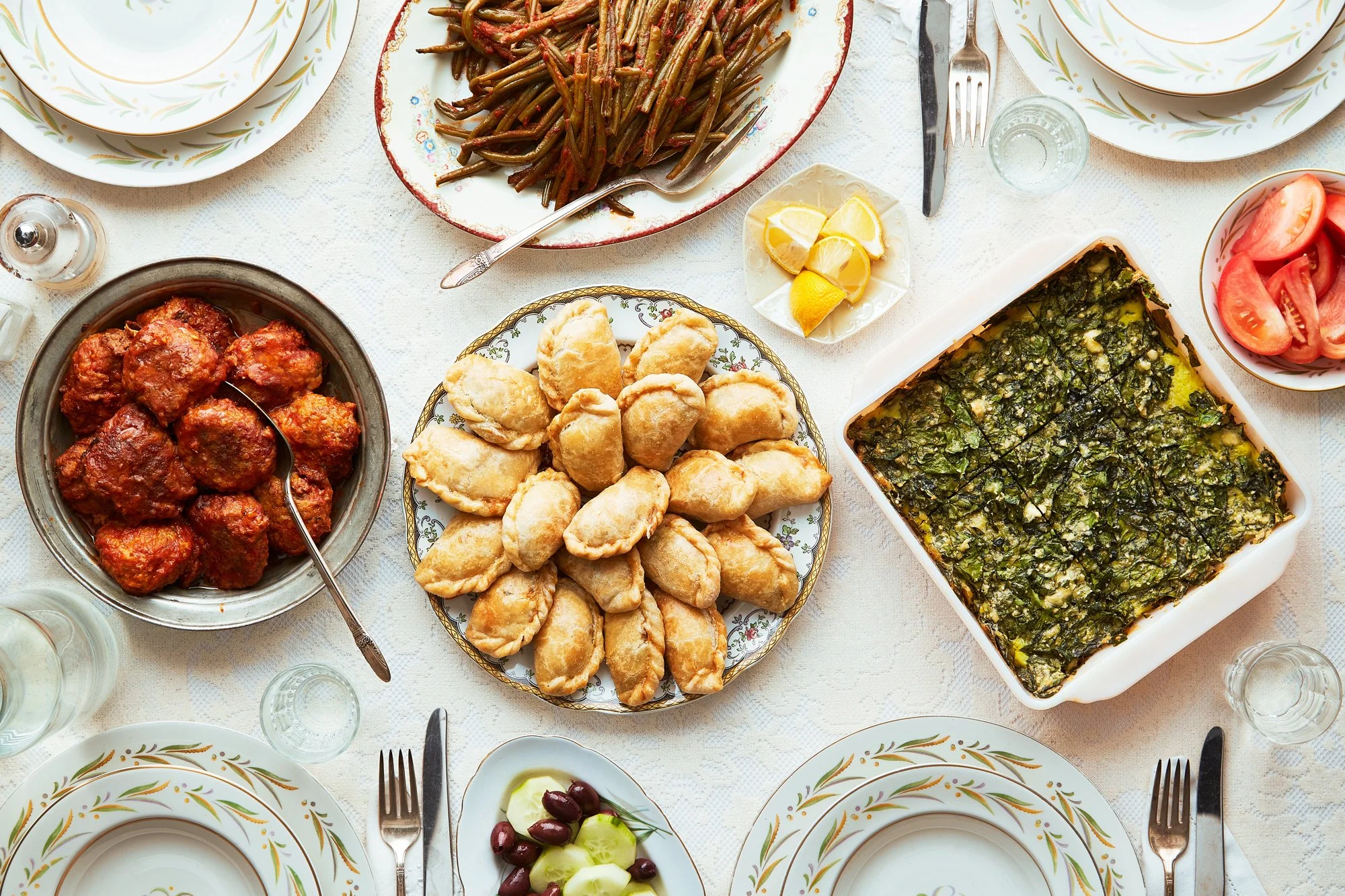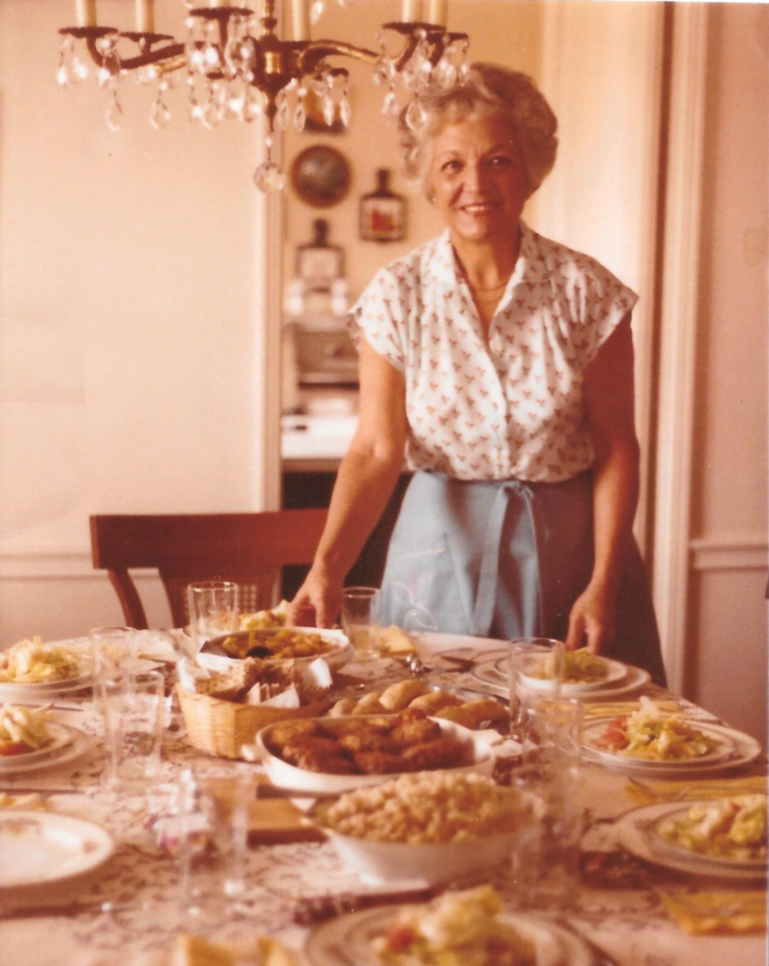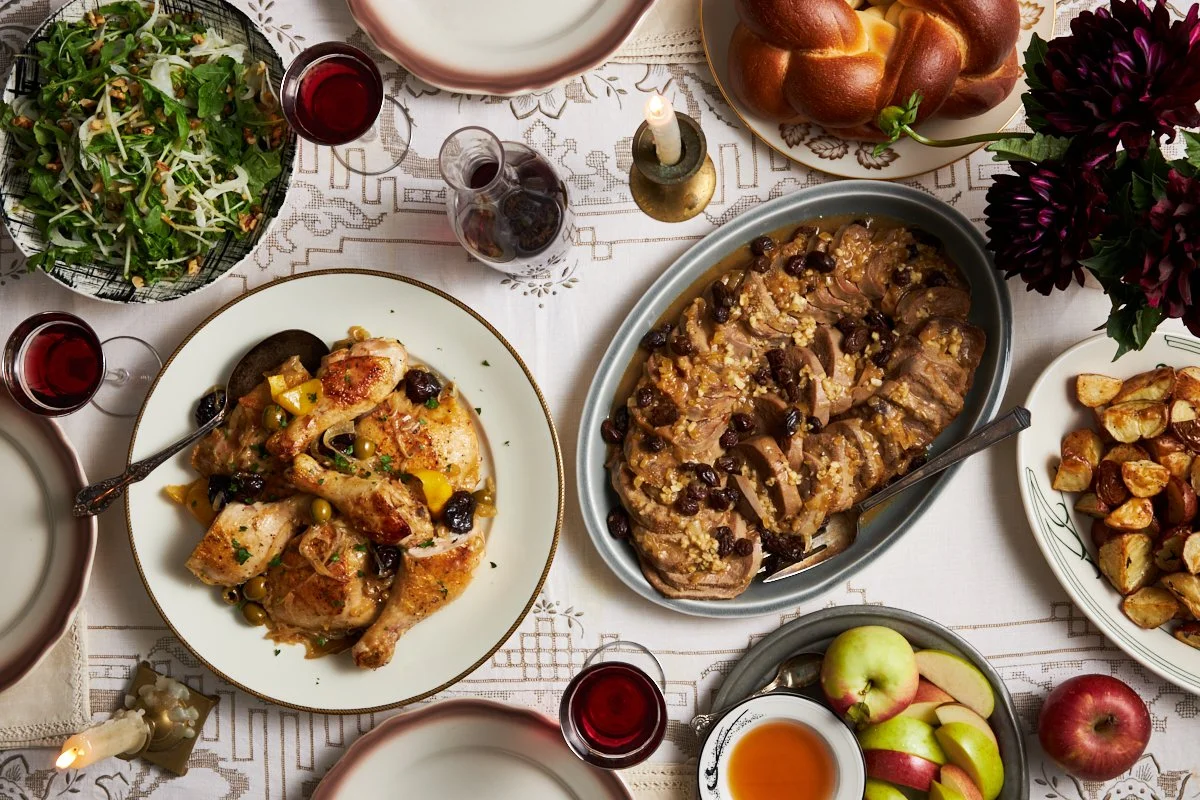The 500-Year-Old Sephardic Recipes That Brought a Network of Cousins Together
Photos by Armando Rafael Photography and Food Styling by Victoria Granof.
Shared by Victoria Granof
Recipe Roots: Spanish Empire (present-day southern Italy) > Çanakkale, Turkey > Chicago > Los Angeles > New York City
Food stylist Victoria Granof remembers cousins from a vast family network in France, Venezuela, Peru, and the U.S. appearing at her dinner table in Los Angeles when she was little. The visiting relatives, “were always modified by their parent’s names,” she explains, like aunt Regina’s Albert and aunt Alegra’s Albert.
In her family, newborns are named for the living — a tradition common in some Sephardic communities — meaning many relatives share their names. Her great-great-grandmother was Victoria Sarah, while her great-grandmother was Rachel Victoria, her grandmother Victoria Rachel, her mother Leah Victoria, and she is Victoria Leah. “It’s really complicated,” she concedes.
Victoria’s “nonie,” Victoria Rachel, serving a spread of Sephardic recipes at her home in West Hollywood, California in the 1980s.
It wasn’t just names that were shared across this family tree, it was recipes, some from southern Italy when it was under Spanish control, and others from Turkey where her family lived for generations.
Victoria remembers a particular dinner when her cousin Arlet came to visit from Paris. Victoria’s mother made an elegant, mid-century American meal, while her grandmother, who she called nonie, brought a second dinner of Sephardic recipes in Corningware over to the house — much to the embarrassment of Victoria’s mother who thought it wasn’t sophisticated fare.
The Sephardic food was left in the kitchen, at first, and “There was kind of a disconnect there until that food came out,” Victoria explains. When it was served, it was clear that everyone at the table was family, she adds. It sparked memories that Arlet shared of other relatives making the same recipes and the days after World War II when they replaced expensive walnuts in sweets called travados de muez with more economical breadcrumbs.
Victoria didn’t always speak the same language as the relatives who visited, she says, but they felt united by the food. “We ate, that’s how we communicated.”
The recipes like those for spinach fritada and meat-filled bourekas were nearly “unchanged for 500 years,” she says. They’re “almost exactly unchanged to what you would get in Spain or Portugal today.” Though, she adds, the name changed from empanadas to bourekas when the family, like many Sephardic Jews, moved to the Ottoman Empire. Others likely joined the family repertoire in Turkey like stuffed grape leaves called yaprak and leek and beef patties called keftes.
Victoria learned to make them from her grandmother growing up and when she lived a block away from her in her 20s. Determined to pass them on to the next generation, Victoria started to write a cookbook for her nieces after her grandmother passed away. As she made the recipes, though, some didn’t taste the way she remembered them. She called her uncle and asked what she was doing wrong. He asked about her ingredients. She had replaced fatty meat from the supermarket with grass-fed beef, and sourced the best vegetables she could find. That was the problem, he said. It’s not how Victoria’s grandmother cooked.
“It never occurred to me that better isn’t better,” she says. Some things simply aren't meant to be changed.
Beef-Filled Bourekas
Makes: About 40 borekas
Total Time: 1 hour active + 8 hours inactive
Ingredients
For the masa (dough):
1 cup vegetable oil
1 cup water
2 teaspoons kosher salt
5 cups all purpose flour
For the beef filling:
1 pound ground chuck beef
1 yellow onion, finely chopped
½ cup water
¼ cup finely chopped parsley
1 ½ teaspoons kosher salt
1 teaspoon ground black pepper
1 tablespoon matzo meal or breadcrumbs
2 hard boiled eggs, peeled and finely chopped
1 uncooked egg
For egg wash:
2 eggs
Preparation
1. Make the masa: Put the flour into a large bowl. In a small pot, bring the oil, water and salt to a boil, over high heat, about 3 minutes. Transfer the mixture from the heat and cool until lukewarm. Add this mixture to the flour and toss together until all the flour is absorbed. Knead the mixture until a dough is formed. Cover with plastic wrap and refrigerate for at least 4 hours or overnight.
2. Make the filling: Place the meat, onion and water into a pan over medium high heat and use a wooden spoon to break up the meat. Cook the mixture until most of the water is absorbed, about 10 minutes, stirring occasionally. Add the salt and pepper and stir. Transfer the mixture into a heatproof bowl and cool until the mixture is at room temperature. Stir in the matzo meal or breadcrumbs and raw egg, then fold in the hardboiled eggs. Mix until combined well.
3. Preheat the oven to 375 ̊.
4. Shape and fill the borekas: Crack the 2 eggs into a small bowl and whisk well. Set aside. Transfer the dough onto a clean work surface. Break off a piece of dough about the size of a heaping tablespoon or walnut. Use your hands or a rolling pin to flatten the dough into a circular piece of dough that is 3-4 inches in diameter. Brush a bit of the egg wash onto the edges of the dough. Place a tablespoon of filling onto the center of the dough. Fold over one side of the dough onto the other, creating a semicirclular shape and covering the filling. Press the edges to seal the filling. Twist the edges into a crimped pattern if desired. Brush the top of the boreka with egg wash and gently transfer it onto a parchment lined sheet tray. Repeat the shaping and stuffing the remaining dough and filling into borekas. Place the borekas about 1 inch apart on the tray.
5. Bake at 375 ̊for 40 minutes or until the borekas are well browned. Transfer out of the oven and eat the borekas warm or at room temperature.
Leek and Beef Keftes
Makes: 4-6 portions
Total Time: 2 hours
Ingredients
4 leeks, trimmed, halved lengthwise then crosswise, and rinsed of all sand
1 pound ground chuck beef
½ cup matzo meal or breadcrumbs
½ cup fresh parsley, finely chopped
2 eggs
1 teaspoon kosher salt
1 teaspoon ground black pepper
To finish:
3 eggs
1 cup matzo cake meal or flour
1 teaspoon kosher salt
1 cup canned tomato puree
Preparation
1. Place the leeks into a pot and cover completely with boiling water. Place the pot over medium heat and simmer for 45 minutes until the leeks are very tender and cooked through. Reserve ½ cup of the cooking liquid. Drain the rest of the liquid from the leeks. Once the leeks are cool enough to handle, use your hands to squeeze out as much liquid as possible from the leeks and then finely chop the leeks. Place the leeks into a mixing bowl. Add the beef, matzo meal or bread crumbs, parsley, eggs, salt and pepper into the bowl. Use your hands to mix the ingredients until combined well. Take about 1 ½ to 2 tablespoons of the mixture and form it into a patty. Repeat with the remaining mixture, about 18 patties should be formed.
2. Preheat the oven to 350 ̊.
3. Dredge and fry the keftes: Beat three eggs in a wide bowl. Place the flour into a separate wide bowl. Set aside. Place enough oil in a wide pan to create ½ inch layer of oil. Place over medium-high heat. Start dredging the keftes: take one patty and gently place it in the flour, completely coating the patty. Shake it to take off any excess flour. Next, dip the patty into the egg mixture until completely coated and drain any excess egg. Carefully place the patty into the hot oil. Repeat with enough pattys that fit into the pan at once without overcrowding, about 5-6. Fry the keftes on both sides until browned, about 2-3 minutes per side. Transfer the keftes into an oven safe baking dish. Repeat dredging and frying the remaining keftes.
4. Make the sauce and bake: Drain all of the oil from the skillet, but don’t wash it. Add the tomato puree and the reserved half cup of the leek water into the pan. Place the pan over high heat and bring the mixture to a simmer, about 5 minutes. Reduce the heat to medium low and cook for another 5 minutes. Carefully pour this sauce over the fried keftes in the baking dish. The sauce should cover the keftes ¾ the way up. Add more water if needed. Cover the baking dish with aluminum foil and transfer into the oven. Bake for 20 minutes. Serve the keftes hot or the next day.
Chef’s note: The keftes taste best one day after they are made. Store in the refrigerator until served. Reheat in a 350 ̊ oven until warm.
Stewed String Beans with Tomatoes
Makes: 4-6 servings
Total Time: 1 hour
Ingredients
1 pound fresh string beans, trimmed and cut in half crosswise if they’re very long
½ cup canned tomato puree
1 teaspoon kosher salt
1 tablespoons olive oil
½ cup water
For garnish (optional):
1 lemon
Ground aleppo pepper
¼ bunch of fresh cilantro leaves, roughly chopped
Preparation
1. Place the string beans, tomato puree, salt, oil and water into a pot over high heat. Bring the mixture to a boil, place a lid on the pot and reduce the heat to medium low. Simmer for 1 hour until the beans are cooked through and the tomato puree has been melted into a sauce. Alternatively, cook the beans in the covered pot in a 350 ̊ preheated oven for 1 hour.
2. Serve the beans at room temperature. Serve with a fresh squeeze of lemon juice, a generous pinch of aleppo pepper and cilantro.
Spinach Fritada
This is a dairy recipe that Victoria’s family traditionally served wit the meal. It can be served separately with a dairy meal as a Kosher-friendly option. Nonie served this fritada with sour cream, which is a very untraditional. Victoria figures that this was the closest they could find to the full-fat yogurt they had in Turkey.
Makes: 4-6 servings
Total Time: 1 hour
Ingredients
1 pound/ 12 cups tightly packed raw spinach, roughly chopped
7 eggs, beaten
¼ cup matzo meal or breadcrumbs
2 cups grated parmesan cheese
1 ½ teaspoon kosher salt
¼ cup olive oil
Sour cream or yogurt for serving
Preparation
1. Preheat the oven to 350 ̊and place a 9” x 13” Pyrex baking dish in the oven to preheat for 10 minutes while making the fritada mixture.
2. Place the spinach in a large bowl and add the eggs, matzo meal or breadcrumbs, parmesan, salt and half of the olive oil. Mix well.
3. Carefully remove the preheated baking dish from the oven and add the remaining olive oil. Use a paper towel to rub the surface and edges of the pan with the oil. Place the fritada mixture into the pan and use a spatula to flatten the top of the fritada into one even layer.
4. Bake uncovered for about 45 minutes, until the fritada is golden brown (the spinach will shrink quite a bit during cooking).
5. Serve warm with a dollop of sour cream or yogurt.
Travados de Muez (Sweet Walnut-Filled Bourekas)
Makes: About 50 travados
Total Time: 1 hour and 30 minutes plus resting, baking and cooling time
Ingredients
For the dough:
2 cups Mazola corn oil
1 cup granulated sugar
1 cup water
7-8 cups all purpose flour
½ teaspoon baking soda
For the filling:
3 cups raw walnuts, finely chopped
1 cup granulated sugar
½ -1 teaspoon ground cinnamon
2 eggs, beaten (reserve a tablespoon for assembly)
For the syrup:
¾ cup granulated sugar
¾ cup honey
¾ cup water
Juice of ¼ lemon
Preparation
1. Make the dough: Mix the oil, sugar and water in a large mixing bowl. Slowly add 7 cups of flour and the baking soda and mix until a soft dough, the consistency of pie dough, is formed. If needed add 1 more tablespoon of flour at a time until the consistency is right. Wrap tightly with plastic wrap and chill for at least 2 hours or overnight.
2. Make the filling: Place the walnuts, sugar, cinnamon and eggs (without the reserved tablespoon) into a bowl. Mix well until combined and set aside.
3. Whisk the remaining tablespoon of egg with a tablespoonful of water in a small bowl and set aside.
4. Preheat the oven to 350 ̊.
5. Shape and stuff the travados: On a lightly floured surface, using your hands or a rolling pin, flatten a tablespoon of dough into an ⅛ inch circle with 2” diameter. Brush the edges with a bit of the egg mixture, add a scant teaspoon of walnut filling onto the center of the dough and fold over, pinching edges to seal. Place the travado onto a parchment lined baking sheet. Repeat shaping and filling the remaining travados and place them 1 inch apart on the baking sheet. Transfer the travados into the oven and bake for 30 minutes, or until golden brown. Cool the travados completely.
6. Make the syrup and soak the travados: Heat the sugar, honey and water in a pot over medium heat, stirring until the sugar is dissolved, continue simmering the syrup for 2-3 minutes. Turn down the heat to medium low, a slow simmer, and with a slotted spoon, drop 3-4 of the travados at a time into the syrup, turning them to coat all sides. After another 2-3 minutes, remove them and place on a lined baking tray; continue this way until all of the travados are soaked.
7. Serve the travados at room temperature. Place each one in a mini paper cupcake liner and serve.






















